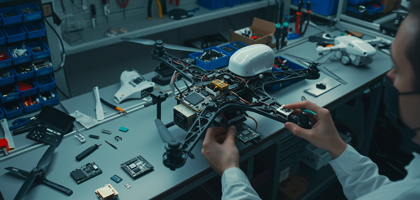

Tata Elxsi and National Aerospace Laboratories
MoU for Advanced Air Mobility and Accelerate Innovation in UAVs, UAM, and eVTOLs for Global Markets.
Read morePowering the Roadmap to Sustainable Aerospace
In an era of heightened environmental consciousness, the aerospace industry is steadily embracing aerospace electrification to transform flight operations. Through electric propulsion, advanced battery technology, and integrated power electronics, airlines are focusing on innovative solutions to reduce carbon emissions and operating costs. Fuel-efficient designs, hybrid-electric architectures, and bold new flight concepts underscore the urgency of creating sustainable aviation for both commercial and defense sectors.
At Tata Elxsi, we collaborate with global aviation leaders to engineer robust electric flight systems for green aviation. From conceptualization to final certification, our expertise fosters zero-emission solutions that merge innovation, safety, and unwavering regulatory compliance.
.jpg )
.jpg )
Here’s How We Can Help You
End-to-End Design & Engineering
- Concept-to-deployment approach leveraging advanced power electronics and electric propulsion
- Robust modeling, simulation, and prototyping ensuring optimal performance, reliability, and safety for diverse electrified aerospace applications and accelerating innovation
Systems Integration & Validation
- Seamless alignment of battery technology, electric drive, and flight control systems
- Comprehensive hardware-in-the-loop and software-in-the-loop testing regimes that mitigate risks and streamline certification for sustainable aviation programs
Regulatory Compliance & Certification Support
- Guidance on evolving global standards for zero-emission and hybrid-electric aircraft
- In-depth expertise addressing safety-critical constraints to globally expedite approvals and ensure compliance with aviation authorities worldwide
Solution Framework
.jpg)
Holistic Engineering Approach
We provide cross-functional expertise in electric propulsion, power electronics, and battery technology to tackle complex aerospace challenges. Our teams align mechanical, electrical, and software disciplines to design integrated solutions that enhance flight efficiency, vigorously reduce operational costs, and meet evolving zero-emission standards without compromising safety or performance.
Power Convertor
We provide cross-functional expertise in electric propulsion, power electronics, and battery technology to tackle complex aerospace challenges. Our teams align mechanical, electrical, and software disciplines to design integrated solutions that enhance flight efficiency, vigorously reduce operational costs, and meet evolving zero-emission standards without compromising safety or performance.
Digital Twinning & Simulation
By creating virtual replicas of electric drive systems and power electronics, we simulate real-world conditions, enabling predictive analytics and scenario testing. This approach ensures faster prototyping, lowers development risk, and helps refine hybrid-electric configurations, ultimately guiding data-driven decisions that accelerate time-to-market for emerging aerospace electrification projects.
Advanced Validation Infrastructure
We leverage specialized test rigs and hardware-in-the-loop setups that replicate operational stressors. By continuously monitoring power electronics load, thermal management, and control algorithms, we ensure reliability and robust compliance. Our end-to-end validation strategy de-risks deployment, shortens global approval cycles, and fuels innovation across the sustainable aviation ecosystem.
Why Tata Elxsi?
- Decades of cross-industry globally recognized expertise driving advanced aerospace electrification solutions for diverse flight applications.
- Integrated engineering and design capabilities ensuring seamless electric propulsion development from complete concept to validation.
- Global compliance knowledge to navigate evolving sustainable aviation regulations and accelerate international certification processes effectively.
- Robust testing methodologies and advanced analytics integrating hardware-in-the-loop systems for reliable, future-ready electrified aerospace platforms.
- Proven track record of delivering zero-emission innovations that boost efficiency, reduce impact, and inspire transformation.
Information Hub
-
What is driving the demand for aerospace electrification?
Global environmental mandates, rising fuel costs, and technological advancements have converged to spark interest in aerospace electrification. Airlines and manufacturers seek ways to minimize emissions and operating expenses, prompting investments in electric propulsion and hybrid-electric systems. Additionally, consumer awareness and government incentives accelerate the push for sustainable aviation. As urban air mobility and eVTOL concepts gain momentum, the industry sees electrification not just as an eco-friendly measure but as a strategic imperative to remain competitive in a evolving market.
-
How do hybrid-electric aircraft differ from fully electric planes?
Hybrid-electric aircraft combine traditional turbines or engines with electric propulsion, allowing partial electrification of flight segments. This approach reduces fuel consumption and emissions while maintaining range and power reliability. In contrast, fully electric planes rely solely on battery technology for all flight operations, which currently limits range and payload capacity. Hybrid-electric designs provide a balanced solution, leveraging existing infrastructure and easing regulatory approval. They also serve as a bridge toward fully electric models by enabling incremental adoption of sustainable aviation practices within today’s operational constraints.
-
What are the major challenges in implementing electric propulsion?
Key hurdles involve battery technology energy density, power electronics cooling, and the added weight of electric drive systems. Limited battery capacity restricts flight range and payload, while thermal management for high-power components remains complex. Additionally, infrastructure for electric propulsion—including charging stations and grid capacity—must be upgraded to accommodate widespread adoption. Regulatory guidelines and rigorous safety testing also shape development timelines. Overcoming these challenges requires ongoing research, innovative material science, and engineering breakthroughs to ensure electric propulsion solutions can compete with conventional aviation alternatives.
-
When will we see widespread adoption of sustainable aviation technology?
Timelines vary as factors like regulatory guidelines, infrastructure readiness, and market demand shape the evolution of sustainable aviation. Some industry forecasts project commercial hybrid-electric aircraft to enter service within the next decade, while fully electric regional planes may take longer. Government incentives and climate policies are accelerating research and development, fueling more prototypes and test flights. As battery technology advances and power electronics become more efficient, the tipping point for widespread adoption will likely occur once cost, range, and reliability align with industry and passenger expectations.
-
How do next-gen battery technology and power electronics impact future aircraft design?
Next-generation battery technology aims to improve energy density, reducing the weight penalty and increasing range for electric propulsion aircraft. These batteries often integrate advanced cooling and management systems to handle high power loads safely. Meanwhile, cutting-edge power electronics enhance efficiency by regulating voltage, current, and thermal profiles in real time. This synergy enables more compact components, lighter wiring, and improved performance across hybrid-electric or fully electric platforms. As a result, aircraft can achieve longer flight durations, lower operating costs, and significantly smaller carbon footprints.







